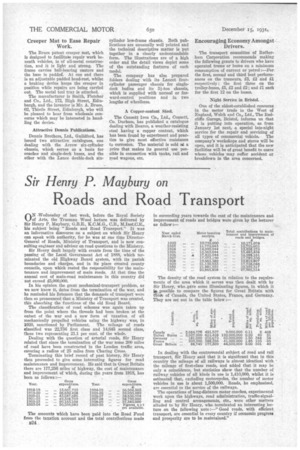Sir Henry P. May bury on
Page 42

If you've noticed an error in this article please click here to report it so we can fix it.
Roads and Road Transport
ON 'Wednesday of last week, before the Royal Society of Arts, the Trueman Wood lecture was delivered by Sir Henry P. Maybury, G.B.E., K.C.M,G., C.13., M.Inst.C.E., his subject being "Roads and Road Transport." It was an informative discourse on a subject on which Sir Henry can speak with authority, for he was at one time DirectorGeneral of Roads, MinistrY of Transport, and is now consulting engineer and adviser on road questions to the Ministry. Sir Henry dealt largely with events from the time of the passing of the Local Government Act of 1888, which terminated the old Highway Board system, with its parish boundaries and charges, and in its place created county councils, upon which rested the responsibility for the maintenance and improvement of main roads. At that time the annual cost of main-road maintenance in this country did not exceed £5,000,000. In his opinion the great mechanical-transport problem, as we now know it, dates from the termination of the war, and he reminded his listeners that the demands of transport were then so pronounced that a Ministry of Transport was created, this absorbing the functions of the old Road Board. The classification of road schemes was again taken up from the point where the threads had been broken at the outset of the war and a new form of taxation of all mechanically propelled vehicles using the highway was, in 2920, sanctioned by Parliament. The mileage of roads classified was 22,756 first class and 14,645 second class, these two representing 21.1 per cent, of the whole. Dealing with the question of arterial roads, Sir Henry related that since the termination of the war some 200 miles of road have been constructed in the London traffic area, covering a radius of 25 miles from Charing Cross. Terminating this brief record of past history, Sir Henry then proceeded to give some interesting figures for road maintenance and improvement. He said that in Great Britain there are 177,256 miles of highway, tlae cost of maintenance and improvement of which, during the years from 1918, has been as follows:— in succeeding years towards the cost of the maintenance and improvement of roads and bridges were given by the lecturer as follow:— The density of the road system in relation to the requirements of the area which it serves was then dealt with by Sir Henry, who-gave some illuminating figures, in which it an possible to compare the figures for Great Britain with thosle of Canada, the United States, France, and Germany. They are set out in the table below In dealing with the controversial subject of road and rail transport, Sir Henry said that it is significant that in this country the mileage of all railways is almost identical with the mileage of first-class roads, and added that it may be only a coincidence' but statistics show that the number of railway vehicles of all kinds in use is 1,410,000, whilst it is estimated that, excluding motorcycles, the number of motor vehicles in use is about 1,500,000. Roads, he emphasized, are essential to the service of the railways. The operations of long-distance motor coaches, experimental work upon the highways, road administration, traffic-signalling and control arrangements, etc., were other matters alluded to by Sir Henry, who terminated an interesting lecture on the following note :—" Good roads, with efficient transport, are essential in every country if economic prozreaa and prosperity are to be maintained."




































































































